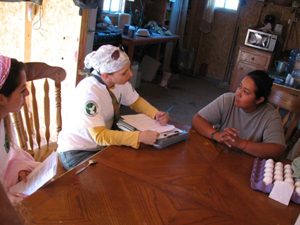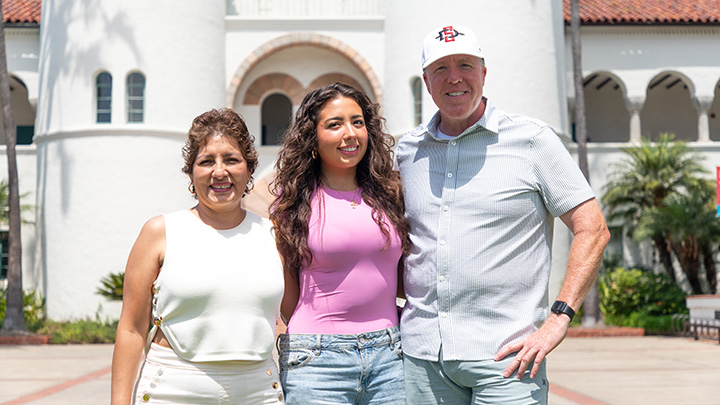Research: From the Lab to Lands Afar
Student learning outside the classroom

A new Facebook app for scientists, disease prevention in Mexico, human-primate interaction, heart cell modification.
What’s the common denominator here? Each of the above is an area of research for students at San Diego State University.
On March 5 and 6, SDSU’s undergraduate, master’s and doctoral students will present their original research on these and other topics at the third annual Student Research Symposium (SRS), a featured SDSU Month event.
The higher purpose
For many undergraduate students, presenting at the SRS is an initiation into the world of serious academe. That’s true of Daniel Cuevas, a computer science major who began working in Professor Robert Edwards’ lab last July.
Building on a new technology called metagenomics, which allows biologists to analyze the DNA of entire communities of microbes, Edwards employs Web 2.0 technologies to annotate DNA sequences in minutes instead of hours or days. The application developed by Cuevas stores and retrieves the metagenome-annotated data on a server, allowing users of social networking sites to share data and analysis with the scientific community more widely and rapidly than ever before.
“Before I began working in Dr. Edwards’ lab, I had only a vague notion of how I could use my computer programming knowledge in the real world,” Cuevas said. “Working with him has really opened my eyes to the higher purpose of learning.”
Going global
Research takes many SDSU students beyond the borders of their own country. Anthropology master’s degree candidate Amanda Sheres spent three months of 2009 in China’s Fanjingshan National Nature Reserve to study the interconnections between humans and primates, specifically the Guizhou snub-nosed monkey.
Her research, guided by Professor Erin Riley, examines possible competition for resources between the primates and the human communities living in and around the nature reserve – competition that could impact the ecology of the Guizhou snub-nosed monkey.
“I came to SDSU specifically because I wanted to work with Dr. Riley,” Sheres said. “She has mentored me at every stage of the research process.”
From student to scientist
Students value the personal and intellectual relationship with faculty that is a result of intensive research. For Kimberlee Fischer, working in Professor Mark Sussman’s molecular biology lab has been critical to her development as a scientist.
Fischer’s research involves inserting cardio-protective genes into stem cells before introducing those cells into the damaged heart of a mouse. In early results, the modified stem cells appear to increase cardiac function.
“I’ve progressed so much as a scientist in Mark’s lab,” Fischer said. “He fosters this incredible atmosphere where all of us—undergraduate, master’s, doctoral and post-doc students—work together and help each other. That’s how I have been able to publish.”
Fischer has co-authored six refereed articles outlining her research in the Sussman lab. On two of them she was lead author, a coup for any doctoral student.
A reputation for research

Within the last decade, San Diego State has earned an international reputation for high quality research, reinforced by its Carnegie Foundation designation as a “research university” with high research activity.
Case in point: Last year, Mexican health officials asked SDSU’s Graduate School of Public Health to assess the potential for an outbreak of Rocky Mountain Spotted Fever (RMSF) in an indigenous colonia in San Quintin. The disease, which had caused some deaths in Mexicali, is transmitted mainly by a tick prevalent in stray dogs.
Working with students from the schools of medicine at UCSD and UABC in Tijuana though a program known as VIIDAI, the SDSU students traveled to rural Mexico to complete the assessment.
“It was a life-changing experience, real epidemiology research at its best,” recalled Saranette Sotomayor, who enrolled in SDSU’s public health program after graduating with a bachelor’s degree in kinesiology.
The students developed a survey tool to assess the potential threat and printed materials to educate the colonia about RMSF prevention. They also collected data and analyzed it in a 25-page paper for the Mexican health authorities.
Each of the students mentioned above will present their original research at the Student Research Symposium next month.
A total of 24 award winners will be selected from among the participants and 10 winners will represent SDSU at the CSU Student Research Competition in San Jose April 30-May 1.
About SDSU Month
The Student Research Symposium is part of the 8th annual SDSU Month, a celebration throughout March of the university's dynamic and enriching relationship with the San Diego community.
SDSU Month will feature 31 days of fun and stimulating academic, arts and athletic events, as well as offers from local businesses and organizations for SDSU's growing family of friends and colleagues. A complete listing of SDSU Month events and other special discounts is available at www.sdsumonth.com.
Related Stories
Researchers Receive Competitive Grants, Top Rankings
SDSU Receives Nearly $134 Million in Research Grants and Contracts



